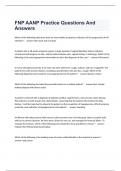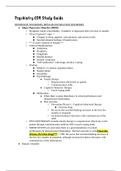Package deal
The Human Body in Health and Illness, 6th Edition
The Human Body in Health and Illness, 6th Edition chapter1_10
[Show more]The Human Body in Health and Illness, 6th Edition chapter1_10
[Show more]1. What is the branch of science that studies how the body functions? a. Anatomy b. Histology c. Pathology d. Physiology ANS: D 2. The foot is located to the leg. a. proximal b. superior c. superficial d. distal ANS: D 3. The leg is to the thigh. a. distal b. proximal c. superior d. deep...
Preview 2 out of 11 pages
Add to cart1. What is the branch of science that studies how the body functions? a. Anatomy b. Histology c. Pathology d. Physiology ANS: D 2. The foot is located to the leg. a. proximal b. superior c. superficial d. distal ANS: D 3. The leg is to the thigh. a. distal b. proximal c. superior d. deep...
1. Which of the following are located in the orbits surrounding the nucleus? a. Isotopes b. Protons c. Electrons d. Neutrons ANS: C 2. The sharing of electrons is referred to as a. covalent bonding. b. ionic bonding. c. radioactive decay. d. isotope formation. ANS: A 3. Which element mus...
Preview 2 out of 11 pages
Add to cart1. Which of the following are located in the orbits surrounding the nucleus? a. Isotopes b. Protons c. Electrons d. Neutrons ANS: C 2. The sharing of electrons is referred to as a. covalent bonding. b. ionic bonding. c. radioactive decay. d. isotope formation. ANS: A 3. Which element mus...
1. Which of the following is considered the control center of the cell? a. Mitochondrion b. Nucleus c. Lysosome d. Centriole ANS: B 2. The mitochondrion is called the power plant of the cell because within the mitochondrion. a. most of the ATP is produced b. all protein synthesis occurs c. ...
Preview 2 out of 13 pages
Add to cart1. Which of the following is considered the control center of the cell? a. Mitochondrion b. Nucleus c. Lysosome d. Centriole ANS: B 2. The mitochondrion is called the power plant of the cell because within the mitochondrion. a. most of the ATP is produced b. all protein synthesis occurs c. ...
1. Which of the following is a nitrogen-containing waste product? a. Glucose b. Adenosine triphosphate c. Carbon dioxide d. Urea ANS: D 2. Which of the following is true of glycogen? a. It is an end-product of fatty acid catabolism. b. It is stored in adipose tissue. c. It is the storage fo...
Preview 2 out of 13 pages
Add to cart1. Which of the following is a nitrogen-containing waste product? a. Glucose b. Adenosine triphosphate c. Carbon dioxide d. Urea ANS: D 2. Which of the following is true of glycogen? a. It is an end-product of fatty acid catabolism. b. It is stored in adipose tissue. c. It is the storage fo...
1. Which of the following is defined as a disease-producing microorganism? a. Normal flora b. Pathogen c. Arthropod d. Parasite ANS: B 2. Influenza is best described as a(n) a. localized infection. b. allergic reaction. c. bacterial infection. d. systemic infection. ANS: D 3. Cocci, bacill...
Preview 2 out of 10 pages
Add to cart1. Which of the following is defined as a disease-producing microorganism? a. Normal flora b. Pathogen c. Arthropod d. Parasite ANS: B 2. Influenza is best described as a(n) a. localized infection. b. allergic reaction. c. bacterial infection. d. systemic infection. ANS: D 3. Cocci, bacill...
1. Which type of tissue is found in orgANS that need to stretch (e.g., urinary bladder)? a. TrANSitional epithelium b. Loose connective tissue c. Adipose tissue d. Simple squamous epithelium ANS: A 2. Which tissue type is the most abundant? a. Epithelial b. Muscular c. Connective d. Nervous ...
Preview 2 out of 11 pages
Add to cart1. Which type of tissue is found in orgANS that need to stretch (e.g., urinary bladder)? a. TrANSitional epithelium b. Loose connective tissue c. Adipose tissue d. Simple squamous epithelium ANS: A 2. Which tissue type is the most abundant? a. Epithelial b. Muscular c. Connective d. Nervous ...
1. The stratum germinativum and the stratum corneum are layers of the a. epidermis. b. hypodermis. c. subcutaneous tissue. d. dermis. ANS: A 2. Which of the following is associated with tanning? a. Sudoriferous glands b. Apocrine glands c. Arrector pili muscles d. Melanocytes ANS: D 3. W...
Preview 2 out of 10 pages
Add to cart1. The stratum germinativum and the stratum corneum are layers of the a. epidermis. b. hypodermis. c. subcutaneous tissue. d. dermis. ANS: A 2. Which of the following is associated with tanning? a. Sudoriferous glands b. Apocrine glands c. Arrector pili muscles d. Melanocytes ANS: D 3. W...
1. The humerus a. is located in the arm. b. is distal to the radius and ulna. c. articulates with the clavicle at the acromioclavicular joint. d. is a bone of the axial skeleton. ANS: A 2. Which bone is found in the skull but not in the cranium? a. Occipital b. Parietal c. Sphenoid d. Mand...
Preview 3 out of 16 pages
Add to cart1. The humerus a. is located in the arm. b. is distal to the radius and ulna. c. articulates with the clavicle at the acromioclavicular joint. d. is a bone of the axial skeleton. ANS: A 2. Which bone is found in the skull but not in the cranium? a. Occipital b. Parietal c. Sphenoid d. Mand...
1. Which of the following muscles is described as striated and involuntary? a. Aponeurosis b. Smooth c. Skeletal d. Cardiac ANS: D 2. The orbicularis oris muscle a. surrounds the mouth. b. flexes the head. c. is the smiling muscle. d. closes the eye. ANS: A 3. Which of the following is not...
Preview 3 out of 18 pages
Add to cart1. Which of the following muscles is described as striated and involuntary? a. Aponeurosis b. Smooth c. Skeletal d. Cardiac ANS: D 2. The orbicularis oris muscle a. surrounds the mouth. b. flexes the head. c. is the smiling muscle. d. closes the eye. ANS: A 3. Which of the following is not...
1x sold
1. Which branching structures carry information toward the cell body of a neuron? a. Synapses b. Axons c. Dendrites d. Nodes of Ranvier ANS: C 2. What is the name of the enzyme that destroys acetylcholine? a. Dopamine b. ACh c. Acetylcholinesterase d. Norepinephrine ANS: C 3. What term d...
Preview 3 out of 19 pages
Add to cart1. Which branching structures carry information toward the cell body of a neuron? a. Synapses b. Axons c. Dendrites d. Nodes of Ranvier ANS: C 2. What is the name of the enzyme that destroys acetylcholine? a. Dopamine b. ACh c. Acetylcholinesterase d. Norepinephrine ANS: C 3. What term d...

Stuvia customers have reviewed more than 700,000 summaries. This how you know that you are buying the best documents.

You can quickly pay through credit card or Stuvia-credit for the summaries. There is no membership needed.

Your fellow students write the study notes themselves, which is why the documents are always reliable and up-to-date. This ensures you quickly get to the core!
You get a PDF, available immediately after your purchase. The purchased document is accessible anytime, anywhere and indefinitely through your profile.
Our satisfaction guarantee ensures that you always find a study document that suits you well. You fill out a form, and our customer service team takes care of the rest.
Stuvia is a marketplace, so you are not buying this document from us, but from seller BestKey. Stuvia facilitates payment to the seller.
No, you only buy these notes for $17.00. You're not tied to anything after your purchase.
4.6 stars on Google & Trustpilot (+1000 reviews)
72001 documents were sold in the last 30 days
Founded in 2010, the go-to place to buy study notes for 14 years now

